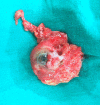Xeroderma pigmentosum: clinicopathological review of the multiple oculocutaneous malignancies and complications
- PMID: 25114464
- PMCID: PMC4116547
- DOI: 10.1007/s13193-014-0307-6
Xeroderma pigmentosum: clinicopathological review of the multiple oculocutaneous malignancies and complications
Abstract
Multiple oculo-cutaneous malignancies are a common manifestation on sun-exposed facial areas in patients with Xeroderma pigmentosum (XP). Commonly seen are the basal cell carcinoma and the squamous cell carcinomas which manifest in the early first decade in contrast to fifth and sixth decade in the general population. XP manifests as photosensitivity, hyperpigmentation, premature skin aging and malignant changes like squamous cell carcinoma, basal cell carcinoma, fibrosarcoma and rarely malignant melanoma as well as internal malignancies. We report 11 cases of Xeroderma pigmentosa managed in our institute which included sex males and five females. All had photosensitivity, hyperpigmentation and consanguinity with facial malignant lesions like SCC and BCC. Ocular signs of photophobia and excessive lacrimation was seen in all the cases while blurring of vision due to corneal clouding, corneal injection, pterygium and limbal SCC were seen in 5 cases. SCC of the lids were seen in 7 cases while BCC seen in 8 cases and limbal and conjunctival SCC seen in one case. All were managed with excision while one case of melanoma with neck secondaries needed radical neck dissection while the other orbital exenteration. Oculo-cutaneous malignancies occur in the sun exposed areas so patients are advised regular follow up with speciality care. Awareness about the rare condition and importance of early detection and prevention of UV rays induced skin damage should be propagated. The disease is ultimately fatal, life can be prolonged by simple preventive measures to minimize sun exposure and early detection of the skin lesions and management.
Keywords: Basal cell carcinoma; Photosensitivity; Squamous cell carcinoma; UV radiation.
Figures
Similar articles
-
Cutaneous malignancies in xeroderma pigmentosum: earlier management improves survival.Indian J Otolaryngol Head Neck Surg. 2013 Apr;65(2):162-7. doi: 10.1007/s12070-012-0614-6. Epub 2013 Jan 5. Indian J Otolaryngol Head Neck Surg. 2013. PMID: 24427558 Free PMC article.
-
Xeroderma Pigmentosum with Simultaneous Cutaneous and Ocular Squamous Cell Carcinoma.Clin Cosmet Investig Dermatol. 2022 Feb 2;15:157-161. doi: 10.2147/CCID.S348771. eCollection 2022. Clin Cosmet Investig Dermatol. 2022. PMID: 35140492 Free PMC article.
-
Verrucous Carcinoma of Tongue in Xeroderma Pigmentosum: A Case Report and Literature Review.Cureus. 2022 Nov 20;14(11):e31706. doi: 10.7759/cureus.31706. eCollection 2022 Nov. Cureus. 2022. PMID: 36561591 Free PMC article.
-
Xeroderma pigmentosum: an updated review.Drugs Context. 2022 Apr 25;11:2022-2-5. doi: 10.7573/dic.2022-2-5. eCollection 2022. Drugs Context. 2022. PMID: 35520754 Free PMC article. Review.
-
Oculocutaneous manifestations in xeroderma pigmentosa.Br J Ophthalmol. 1994 Apr;78(4):295-7. doi: 10.1136/bjo.78.4.295. Br J Ophthalmol. 1994. PMID: 8199117 Free PMC article. Review.
Cited by
-
A Systematic Review and Meta-Analysis of Ocular and Periocular Basal Cell Carcinoma with First-Time Description of Dermoscopic and Reflectance Confocal Microscopy Features of Caruncle Basal Cell Carcinoma.Diagnostics (Basel). 2025 May 14;15(10):1244. doi: 10.3390/diagnostics15101244. Diagnostics (Basel). 2025. PMID: 40428237 Free PMC article. Review.
-
Late Presentation of Xeroderma Pigmentosa With Squamous Cell Carcinoma in Septic Shock: Report of a Rare Case.Cureus. 2022 Jun 15;14(6):e25967. doi: 10.7759/cureus.25967. eCollection 2022 Jun. Cureus. 2022. PMID: 35855222 Free PMC article.
-
Whole Exome Sequencing of a Patient with a Milder Phenotype of Xeroderma Pigmentosum Group C.Medicina (Kaunas). 2023 Apr 3;59(4):699. doi: 10.3390/medicina59040699. Medicina (Kaunas). 2023. PMID: 37109656 Free PMC article.
-
hSSB2 (NABP1) is required for the recruitment of RPA during the cellular response to DNA UV damage.Sci Rep. 2021 Oct 12;11(1):20256. doi: 10.1038/s41598-021-99355-0. Sci Rep. 2021. PMID: 34642383 Free PMC article.
-
Recurrent squamous cell carcinoma and a novel mutation in a patient with xeroderma pigmentosum: a case report.J Med Case Rep. 2022 Jul 28;16(1):306. doi: 10.1186/s13256-022-03524-2. J Med Case Rep. 2022. PMID: 35902966 Free PMC article.
References
-
- Mohanty P. Mohanty l, Devi BP, multiple cutaneous malignancies in xeroderma pigmentosum. Indian J Dermatol Venereol Leprol. 2001;67:96–97. - PubMed
-
- Ramachandra I, Shenoi KR, Santosh Pai U. Xeroderma pigmentosa in siblings: cystosarcoma phylloides in a case of xeroderma pigmentosa. Indian J Dermatol Venereol Leprol. 2002;68:168–170. - PubMed
LinkOut - more resources
Full Text Sources
Other Literature Sources
Research Materials




